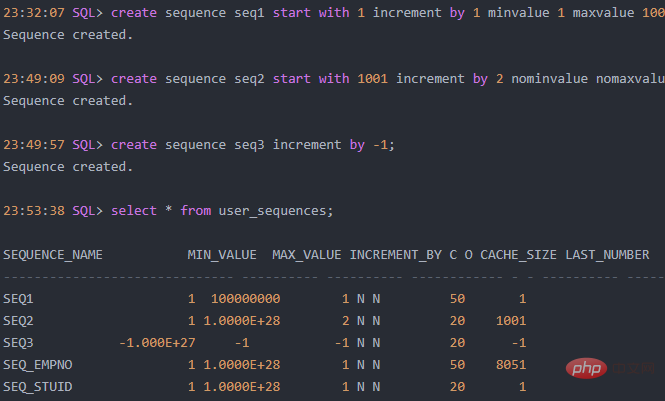What is oracle sequence
In Oracle, a sequence is a database object used to generate a series of unique numbers; a sequence is a sequence number generator that can automatically generate sequence numbers for rows in a table. Its main purpose is to generate primary keys. value, and the user defining the sequence must have CREATE SEQUENCE permission.

The operating environment of this tutorial: Windows 10 system, Oracle 11g version, Dell G3 computer.
What is Oracle sequence
Sequence: Sequence is a database object provided by Oracle for generating a series of unique numbers. Since there is no method to set up an auto-increment column in Oracle, we mainly use sequences to implement the primary key auto-increment function in the Oracle database.
In Oracle database, sequence is actually a sequence number generator, which can automatically generate sequence numbers for rows in the table. Its main purpose is to generate the primary key value of the table. Equivalent to the auto-increment field in SQL Server and MySQL.
In SQL Server, you can use the identity keyword when defining the primary key. In MySQL, you can use the increment keyword when defining the primary key. If you want to use auto-increment fields in Oracle database, you must first define a sequence object, and then use [sequence object name.nextval] to insert auto-increment data in the primary key when inserting data.
To define a sequence, the user defining the sequence must have CREATE SEQUENCE permission. In the Oracle database, the syntax for defining a sequence is as follows:
CREATE SEQUENCE 序列名 [START WITH n] [INCREMENT BY n] [MAXVALUE n|NOMAXVALUE] [MINVALUE n|NOMINVALUE] [CACHE n|NOCACHE] [CYCLE|NOCYCLE]
Parameter description:
(1) INCREMENT BY: Define the step size of the sequence. If n is a positive value, it means that the sequence is an increment Sequence; if n is a negative value, it means that the sequence is a decreasing sequence; if omitted, the default value is 1.
(2) START WITH: Defines the starting value of the sequence. If omitted, the default value is 1.
(3) MAXVALUE: Defines the maximum value that the sequence generator can produce. The option NOMAXVALUE is the default option, which means that there is no maximum value definition. At this time, for the increasing sequence, the maximum value that the system can generate is 10 to the 27th power; for the decreasing sequence, the maximum value is -1.
(4) MINVALUE: Define the minimum value that the sequence generator can produce. The option NOMAXVALUE is the default option, which means that there is no minimum value definition. At this time, for the descending sequence, the minimum value that the system can generate is -10 to the 26th power; for the increasing sequence, the minimum value is 1.
(5) CYCLE|NOCYCLE: Indicates whether to loop when the value of the sequence generator reaches the limit value. CYCLE stands for cycle and NOCYCLE stands for no cycle.
(6) CACHE: Define the size of the memory block to store the sequence, the default is 20. NOCACHE means no memory buffering of the sequence.
Examples are as follows:

Expand knowledge:
Modify the sequence
Format:
ALTER SEQUENCE name [INCREMENT BY n]
[MINVALUE n | NO MINVALUE]
[MAXVALUE n | NO MAXVALUE ]
[MINVALUE n | NO MINVALUE ]
[CACHE n ]
[CYCLE | NO CYCLE]Examples are as follows:

Oracle Video Tutorial"
The above is the detailed content of What is oracle sequence. For more information, please follow other related articles on the PHP Chinese website!

Hot AI Tools

Undresser.AI Undress
AI-powered app for creating realistic nude photos

AI Clothes Remover
Online AI tool for removing clothes from photos.

Undress AI Tool
Undress images for free

Clothoff.io
AI clothes remover

Video Face Swap
Swap faces in any video effortlessly with our completely free AI face swap tool!

Hot Article

Hot Tools

Notepad++7.3.1
Easy-to-use and free code editor

SublimeText3 Chinese version
Chinese version, very easy to use

Zend Studio 13.0.1
Powerful PHP integrated development environment

Dreamweaver CS6
Visual web development tools

SublimeText3 Mac version
God-level code editing software (SublimeText3)

Hot Topics
 1386
1386
 52
52
 How to check tablespace size of oracle
Apr 11, 2025 pm 08:15 PM
How to check tablespace size of oracle
Apr 11, 2025 pm 08:15 PM
To query the Oracle tablespace size, follow the following steps: Determine the tablespace name by running the query: SELECT tablespace_name FROM dba_tablespaces; Query the tablespace size by running the query: SELECT sum(bytes) AS total_size, sum(bytes_free) AS available_space, sum(bytes) - sum(bytes_free) AS used_space FROM dba_data_files WHERE tablespace_
 How to view instance name of oracle
Apr 11, 2025 pm 08:18 PM
How to view instance name of oracle
Apr 11, 2025 pm 08:18 PM
There are three ways to view instance names in Oracle: use the "sqlplus" and "select instance_name from v$instance;" commands on the command line. Use the "show instance_name;" command in SQL*Plus. Check environment variables (ORACLE_SID on Linux) through the operating system's Task Manager, Oracle Enterprise Manager, or through the operating system.
 How to encrypt oracle view
Apr 11, 2025 pm 08:30 PM
How to encrypt oracle view
Apr 11, 2025 pm 08:30 PM
Oracle View Encryption allows you to encrypt data in the view, thereby enhancing the security of sensitive information. The steps include: 1) creating the master encryption key (MEk); 2) creating an encrypted view, specifying the view and MEk to be encrypted; 3) authorizing users to access the encrypted view. How encrypted views work: When a user querys for an encrypted view, Oracle uses MEk to decrypt data, ensuring that only authorized users can access readable data.
 How to uninstall Oracle installation failed
Apr 11, 2025 pm 08:24 PM
How to uninstall Oracle installation failed
Apr 11, 2025 pm 08:24 PM
Uninstall method for Oracle installation failure: Close Oracle service, delete Oracle program files and registry keys, uninstall Oracle environment variables, and restart the computer. If the uninstall fails, you can uninstall manually using the Oracle Universal Uninstall Tool.
 How to delete all data from oracle
Apr 11, 2025 pm 08:36 PM
How to delete all data from oracle
Apr 11, 2025 pm 08:36 PM
Deleting all data in Oracle requires the following steps: 1. Establish a connection; 2. Disable foreign key constraints; 3. Delete table data; 4. Submit transactions; 5. Enable foreign key constraints (optional). Be sure to back up the database before execution to prevent data loss.
 How to solve the problem of closing oracle cursor
Apr 11, 2025 pm 10:18 PM
How to solve the problem of closing oracle cursor
Apr 11, 2025 pm 10:18 PM
The method to solve the Oracle cursor closure problem includes: explicitly closing the cursor using the CLOSE statement. Declare the cursor in the FOR UPDATE clause so that it automatically closes after the scope is ended. Declare the cursor in the USING clause so that it automatically closes when the associated PL/SQL variable is closed. Use exception handling to ensure that the cursor is closed in any exception situation. Use the connection pool to automatically close the cursor. Disable automatic submission and delay cursor closing.
 How to check invalid numbers of oracle
Apr 11, 2025 pm 08:27 PM
How to check invalid numbers of oracle
Apr 11, 2025 pm 08:27 PM
Oracle Invalid numeric errors may be caused by data type mismatch, numeric overflow, data conversion errors, or data corruption. Troubleshooting steps include checking data types, detecting digital overflows, checking data conversions, checking data corruption, and exploring other possible solutions such as configuring the NLS_NUMERIC_CHARACTERS parameter and enabling data verification logging.
 How to create cursors in oracle loop
Apr 12, 2025 am 06:18 AM
How to create cursors in oracle loop
Apr 12, 2025 am 06:18 AM
In Oracle, the FOR LOOP loop can create cursors dynamically. The steps are: 1. Define the cursor type; 2. Create the loop; 3. Create the cursor dynamically; 4. Execute the cursor; 5. Close the cursor. Example: A cursor can be created cycle-by-circuit to display the names and salaries of the top 10 employees.




